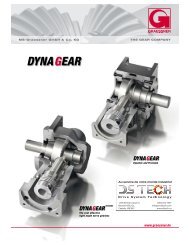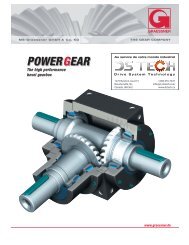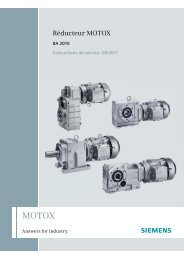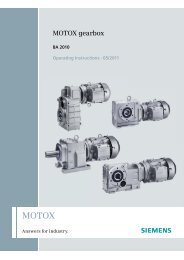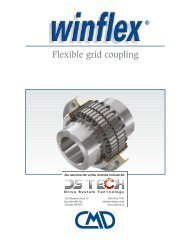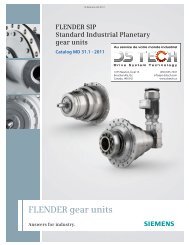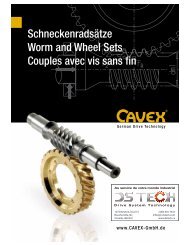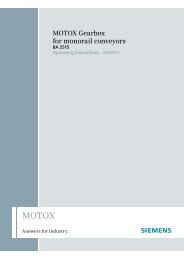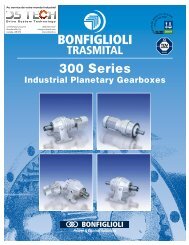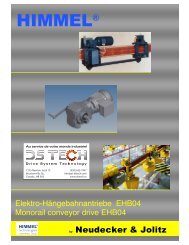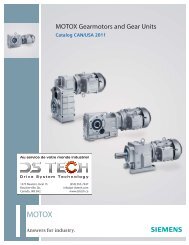FLENDER Standard Couplings - DS TECH
FLENDER Standard Couplings - DS TECH
FLENDER Standard Couplings - DS TECH
- No tags were found...
You also want an ePaper? Increase the reach of your titles
YUMPU automatically turns print PDFs into web optimized ePapers that Google loves.
© Siemens AG 2011<br />
<strong>FLENDER</strong> <strong>Standard</strong> <strong>Couplings</strong><br />
Highly Flexible <strong>Couplings</strong> — ELPEX-S Series<br />
General information<br />
Coupling load under maximum and overload conditions<br />
The maximum torque is the highest load acting on the coupling<br />
in normal operation.<br />
Maximum torques at a frequency of up to 25 times an hour are<br />
permitted and must be lower than the maximum coupling torque.<br />
Examples of maximum torque conditions are: Starting operations,<br />
stopping operations or usual operating conditions with<br />
maximum load.<br />
T Kmax ≥ T max ⋅ FT<br />
Overload torques are maximum loads which occur only in combination<br />
with special, infrequent operating conditions.<br />
Examples of overload torque conditions are: Motor short circuit,<br />
emergency stop or blocking because of component breakage.<br />
Overload torques at a frequency of once a month are permitted<br />
and must be lower than the maximum overload torque of the<br />
coupling. The overload condition may last only a short while, i.e.<br />
fractions of a second.<br />
T KOL ≥ T OL ⋅ FT<br />
Coupling load due to dynamic torque load<br />
Applying the frequency factor FF, the dynamic torque load must<br />
be lower than the coupling fatigue torque.<br />
Dynamic torque load<br />
T KW ≥ T W ⋅ FT ⋅ FF ⋅<br />
0.6<br />
FB – 1.0<br />
Checking the maximum speed<br />
The following must apply to all load situations: n Kmax ≥ n max<br />
The maximum speed of a size depends only on the size of the<br />
outer flange (part 3).<br />
Checking permitted shaft misalignment and restorative<br />
forces<br />
For all load situations, the actual shaft misalignment must be less<br />
than the permitted shaft misalignment.<br />
Checking bore diameter, mounting geometry and<br />
coupling design<br />
The check must be made on the basis of the dimension tables.<br />
On request, couplings with adapted geometry can be provided.<br />
Checking shaft-hub connection<br />
Please refer to catalog section 3 for instructions.<br />
Checking temperature and chemically aggressive<br />
environment<br />
The permitted coupling temperature is specified in the Temperature<br />
Factor FT table. In the case of chemically aggressive environments,<br />
please consult the manufacturer.<br />
1275 Newton, local 15<br />
Boucherville, Qc,<br />
Canada, J4B 5H2<br />
Frequency of the dynamic torque load<br />
f err ≤ 10 Hz frequency factor FF = 1.0<br />
Frequency of the dynamic torque load<br />
f err >10Hzfrequency factorFF=√ (f err /10 Hz)<br />
Operation in potentially explosive environments is subject to<br />
the following restriction:<br />
Operation with low fatigue load<br />
The fatigue torque T KW must be reduced by 70 %. In these<br />
particular operating conditions the coupling satisfies the requirements<br />
of temperature class T4 D120 °C.<br />
Operation with medium fatigue load<br />
The fatigue torque T KW must be reduced by 50 %. In these<br />
particular operating conditions the coupling satisfies the requirements<br />
of temperature class T3 D160 °C.<br />
11<br />
(450) 655-7447<br />
info@pt-dstech.com<br />
www.dstech.ca<br />
Siemens MD 10.1 · 2011<br />
11/5



